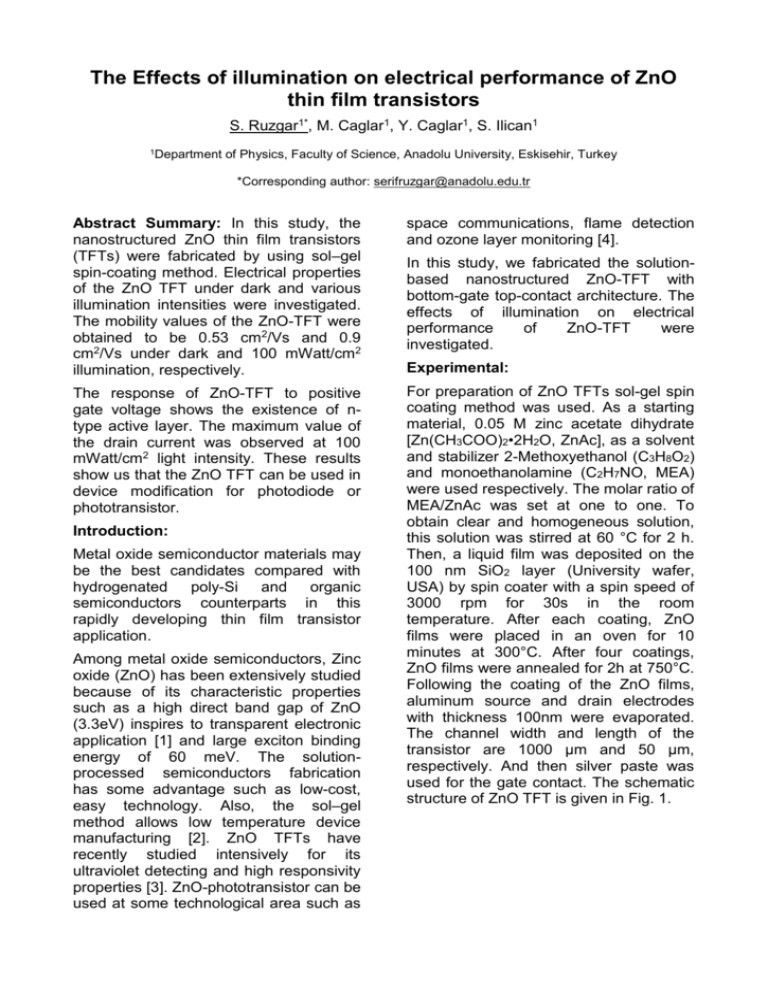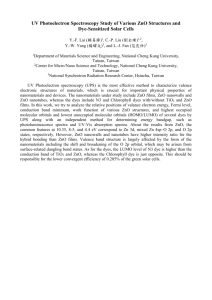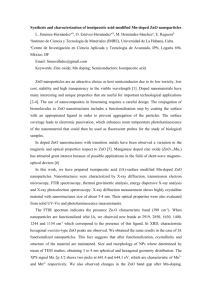The Effects of illumination on electrical performance of ZnO thin film
advertisement

The Effects of illumination on electrical performance of ZnO thin film transistors S. Ruzgar1*, M. Caglar1, Y. Caglar1, S. Ilican1 1Department of Physics, Faculty of Science, Anadolu University, Eskisehir, Turkey *Corresponding author: serifruzgar@anadolu.edu.tr Abstract Summary: In this study, the nanostructured ZnO thin film transistors (TFTs) were fabricated by using sol–gel spin-coating method. Electrical properties of the ZnO TFT under dark and various illumination intensities were investigated. The mobility values of the ZnO-TFT were obtained to be 0.53 cm2/Vs and 0.9 cm2/Vs under dark and 100 mWatt/cm2 illumination, respectively. space communications, flame detection and ozone layer monitoring [4]. The response of ZnO-TFT to positive gate voltage shows the existence of ntype active layer. The maximum value of the drain current was observed at 100 mWatt/cm2 light intensity. These results show us that the ZnO TFT can be used in device modification for photodiode or phototransistor. For preparation of ZnO TFTs sol-gel spin coating method was used. As a starting material, 0.05 M zinc acetate dihydrate [Zn(CH3COO)2•2H2O, ZnAc], as a solvent and stabilizer 2-Methoxyethanol (C3H8O2) and monoethanolamine (C2H7NO, MEA) were used respectively. The molar ratio of MEA/ZnAc was set at one to one. To obtain clear and homogeneous solution, this solution was stirred at 60 °C for 2 h. Then, a liquid film was deposited on the 100 nm SiO2 layer (University wafer, USA) by spin coater with a spin speed of 3000 rpm for 30s in the room temperature. After each coating, ZnO films were placed in an oven for 10 minutes at 300°C. After four coatings, ZnO films were annealed for 2h at 750°C. Following the coating of the ZnO films, aluminum source and drain electrodes with thickness 100nm were evaporated. The channel width and length of the transistor are 1000 µm and 50 µm, respectively. And then silver paste was used for the gate contact. The schematic structure of ZnO TFT is given in Fig. 1. Introduction: Metal oxide semiconductor materials may be the best candidates compared with hydrogenated poly-Si and organic semiconductors counterparts in this rapidly developing thin film transistor application. Among metal oxide semiconductors, Zinc oxide (ZnO) has been extensively studied because of its characteristic properties such as a high direct band gap of ZnO (3.3eV) inspires to transparent electronic application [1] and large exciton binding energy of 60 meV. The solutionprocessed semiconductors fabrication has some advantage such as low-cost, easy technology. Also, the sol–gel method allows low temperature device manufacturing [2]. ZnO TFTs have recently studied intensively for its ultraviolet detecting and high responsivity properties [3]. ZnO-phototransistor can be used at some technological area such as In this study, we fabricated the solutionbased nanostructured ZnO-TFT with bottom-gate top-contact architecture. The effects of illumination on electrical performance of ZnO-TFT were investigated. Experimental: Acknowledgement: This work was supported by Anadolu University Commission of Scientific Research Project under Grant No. 1101F009 and under Grant No.1501F030. References G. Cramer, “Fabrication and Comparison of ZnO Thin Film Transistors with Various Gate Insulators,” ELECTRONICS, Nnin. Reu. 2006, Research Accomplishments [2] K.J. Chen, F.Y. Hung, S.J. Chang, S.J. Young, ‘’Optoelectronic characteristics of UV photodetector based on ZnO nanowire thin films’’, J Alloys Compd, 479 (2009), p. 674 [3] H.S. Bae, M.H. Yoon, J.H. Kim, S. Im, ‘’Photodetecting properties of ZnO based thinfilm transistors’’ Appl. Phys. Lett., 83 (2003), p. 5313 [4] W. Y. Weng, S. J. Chang, C. L. Hsu, and T. J. Hsueh,’’ A ZnO-Nanowire Phototransistor Prepared on Glass Substrates’’, ACS Appl. Mater. Interfaces, 3 (2011), p.162–166 [1] Fig. 1. Schematic structure of ZnO TFT. Fig. 2. Plots of Id vs. Vd of the ZnO TFT under various illuminations at Vg=0V.




